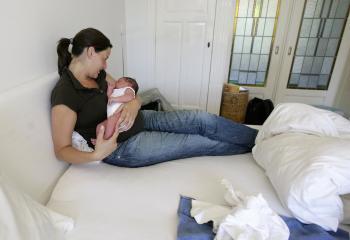Normal
0
false
false
false
MicrosoftInternetExplorer4
/* Style Definitions */ table.MsoNormalTable {mso-style-name:“Table Normal”; mso-tstyle-rowband-size:0; mso-tstyle-colband-size:0; mso-style-noshow:yes; mso-style-parent:"“; mso-padding-alt:0in 5.4pt 0in 5.4pt; mso-para-margin:0in; mso-para-margin-bottom:.0001pt; mso-pagination:widow-orphan; font-size:10.0pt; font-family:”Times New Roman"; mso-ansi-language:#0400; mso-fareast-language:#0400; mso-bidi-language:#0400;}
Names have been changed to protect the identity of the laboring mother.
Student Midwife Dana Gordon enters a small cottage birthing home and instantly knows something is wrong. She has been asked to sit in with a woman whose birth is being hindered. Across the room is a young woman on her hands and knees. Dana senses that this woman’s body position reveals a difficult internal state; an emotional pain beyond typical labor. Having dilated only three centimeters, Dana senses that this woman is dealing with more than just childbirth. This woman is not simply giving birth; she is facing and reliving physical and emotional trauma from years ago that is now affecting her birthing.
As a midwife, Dana has learned to hone her intuition when assisting clients. In a world where so many girls are victims of sexual abuse, emotional counseling is often a critical component of healthy birthing for mothers and their newborn.
“Women who are survivors of childhood sexual abuse often present a wide array of symptoms. Frequently, the underlying cause of these symptoms is unrecognized by both the physician and the patient,” according to the 2011 American Congress of Obstetricians and Gynecologists (ACOG) Committee Opinion No. 498 titled Adult Manifestations of Childhood Sexual Abuse. Some women may have trouble breastfeeding or bonding with their newborns. In extreme cases, some women simply can’t birth.
According to the ACOG Opinion, “Pregnancy and childbirth may be an especially difficult time for survivors. The physical pain of labor and delivery may trigger memories of past abuse. Women with no prior conscious memories of their abuse may begin to experience emotions, dreams, or partial memories.” “Approximately one in five women has experienced childhood sexual abuse,” although the ACOG Opinion acknowledges it could be as high as forty percent.
Three centimeters is well short of the ten needed for a baby to emerge. Dana recalls, “Everyone knew that this woman would be laboring for several more hours at least. In fact, Paula had been laboring like this for the last three days.” The lead midwife leaves, telling Dana, “She’s not progressing; she just needs someone to be present.”
Back inside the room, Paula’s wild eyes are darting. Dana is careful not to disrupt the path of a birthing mother. Instead, she studies Paula. There is no eye contact. There is no peace. It feels very uncomfortable. “I thought to myself,” says Dana, “this is not a normal birth process. She is so lost. She is in fear. She is in fight or flight. She is in her terror—in her abuse. And at this moment, this is her idea of birth.”
Paula was not only experiencing the challenge of delivering her and her husband’s child. She would have to overcome a mountain of lifelong suppression.
“There is something sacred about rhythm,” says Dana. “There are rhythmic screams of natural childbirth and then there are screams of hysteria.” Dana knows to wait for a pattern. Does the birthing woman compose herself using rhythm or is she frantic?
Dana finds no pattern in Paula’s labor. She is out of control and fear is enveloping her. No one is expecting Paula to birth right now, but Dana’s intuition finally moves her to the woman’s side.
After 30 minutes of silent observance, Dana finally asks, “Who did this to you?” Paula stops. “It was the first time she made eye contact with me,” Dana recalls, “I wondered if she even knew the nature of my question.” Paula raises her finger toward the empty corner. She is now focused with an intention that was not achievable a moment earlier. Instantly and without words, Dana can imagine what happened to Paula long ago in a corner just like the one in front of them now.
Dana senses what’s going on inside Paula’s head. Dana responds in a low primal tone, “Tell him to get out. He doesn’t belong here. This is too sacred. Don’t let him be here. Get him out.”
Paula mumbles something unintelligible, but her energy is shifting. Her momentum is building and she is using a focus that was not present before. Dana said, “I watched her go into herself. She was now empowered, trusting.” Then Paula breaks and her mind points her eyes to the corner again. “Get him out,” repeats Dana, “You won’t open with him. Get him out.”
Paula is going back inside herself now. She is breathing, and doing it rhythmically. “She looked up at me and her eyes had changed,” said Dana. “I had been coaching her for only ten minutes. She looked up at me and said, ‘I have to push.’”
Now Dana is yelling to get the attention of the other student midwives to bring the lead midwife back. Could it be that birth is imminent? Dana pulls up Paula’s dress and finds that the infant is crowning. The little one is finally being permitted to emerge.
Paula then birthed her son successfully, and faster than anyone could imagine.
I asked Dana, now a seasoned midwife, “What is the importance of this experience for you?” Dana answered, “It has made such an impact on me and how I practice. I absolutely carry this so deeply within me. I know that she was on the floor like that with tremendous purpose. Everyone had discredited where she was. It would have been easy to tell her to go home. I could have disregarded the importance of what was happening.”
Dana pauses before continuing, “She would have ultimately been a candidate for C-section. She never would have confronted what this fear was, or overcome it. Her baby gave her the opportunity. And now she takes that into parenthood. We all climb mountains when we birth, but…wow. She definitely left that birth with different eyes, and that will penetrate everything she does. That’s how you change the world.”
Dana is now involved in a project to identify Post Traumatic Stress Syndrome in birthing. The project is looking to find victims of sex offenders and sexual abuse to answer the question, “Can emotional therapy help?”
James Goodlatte is the founder of Fit For Birth, Inc., and a Pre & Post Natal Holistic Health Coach. His passion is to heal families by inspiring the use of natural methods and by building a team of fitness professionals to reduce infertility, avoid mechanized childbirth, and lower chronic disease in our infants. Fit For Birth provides continuing education courses for fitness and birth professionals, as well as various personal training and health coaching programs for pre and postnatal women.
For more information or to speak with a midwife, please go to www.GetFitForBirth.com.
Like us on facebook.com/GetFitForBirth
Follow us on Twitter @FitForBirth




